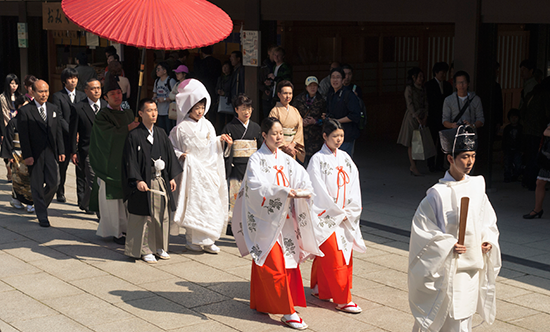
August-
September 2015
Family in Focus
------------------
|






Wedding traditions around the world...
Here Comes the Bride
Traditions, rituals, customs,
and norms distinguish cultures. Even in our modern,
shrinking world, courtship and marriage often remain tightly ensconced in the traditions and rituals of the past. Several overseas missionaries provide a glimpse into courtship and marriage in their host countries.
Japan,
by Sandra Bishop
Traditionally, Japanese weddings are Shinto. Immediate family and a select number of guests attend the ceremony held at the Shinto shrine. In a traditional Shinto wedding (pictured below), the bride is painted white and wears a white wedding kimono. The groom wears a formal black and grey kimono. The groom, bride, and both sets of parents drink sake (rice wine) in three sips to represent the unity of the couple and their families. This takes the place of vows.
Recently, the wedding scene has changed. Modern couples combine Western, Christian, and sometimes Buddhist wedding traditions in their ceremonies. Usually, the weddings are both civil and religious. At the least, a marriage must be registered to be legal.
In the last 20 years, the trend is to have a church or chapel wedding, in spite of the fact that less than 1% of the population is Christian. Some pastors and missionaries use this opportunity to minister to couples and counsel them on a biblical understanding of marriage. Wedding chapels, often connected with large hotels, are a booming business, especially since many towns and villages don’t have even one church.

To save money, some young couples have private ceremonies with only family present. Wedding gifts are monetary, if given at all. Instead, gifts are given to the guests who pay to attend the reception.
A white wedding gown is more the norm these days. In a tradition dating back to the 14th century, the bride changes clothes several times during the reception. At some weddings, a wedding gown is followed by one or two different evening gowns, sometimes a kimono, and ends with a nice going away outfit. This signifies the bride is ready to return to everyday life—now as a wife.
Until the 1970s, 40% of weddings were arranged marriages. A third party acted as a go-between for Omiai (introductory meeting) between a man and woman. The Omiai involved the two parties meeting at a neutral location after viewing the profiles of several individuals and deciding one person might be compatible and, possibly, a good match. Sometimes, it took several meetings with different individuals before a match was found. Finances, temperament, family history, and personal appearance, among other things, were considered.
According to church friends and English students with whom I talked, arranged marriages are no longer the norm. Most people meet at school, university, on the job, or through introductions by a friend. They had to think really hard to come up with a friend whose marriage had been arranged, and some couldn’t think of anyone who fell into that category.
Family relationships are also changing. In the past, the oldest son continued to reside at home after marriage, taking care of his parents and, finally, inheriting everything. This still happens, though more often the son and his wife live apart from the parents and take care of them from a distance. The wife becomes a member of the husband’s family after marriage. This often results in her feeling controlled, watched, criticized, and demeaned by the in-laws. Though better these days, this still occurs.
Changes are taking place on the domestic front as well. In the past, men worked and did little at home, leaving domestic responsibilities to the wife. Today, however, husbands help with different chores: cooking, cleaning, laundry, minor repairs, yard work, etc.
Christian weddings are usually held in a church and look more like what Americans know. I was surprised the first time I attended a church wedding here in Japan and heard a sermon. I like it, because unsaved family members and friends often attend. This offers a chance for the gospel to be presented, as well as the biblical view of marriage. Some of the traditions, like changing clothes during the reception, carry over into Christian weddings. Most other traditions don’t because they are connected with the Shinto religion.
Lobi, Côte d’Ivoire,West Africa, by Clint and Lynette Morgan
Growing up with the western style of dating, engagement, and marriage, I was intrigued by the practices of the Lobi people when we arrived for ministry in Côte d’Ivoire.
The Lobi are a farming, hunting, warring people who live in the northeast corner of Côte d’Ivoire and bordering countries. They have no real homeland because they are semi-nomadic, moving when grazing land becomes scarce or soil no longer produces good crops. As it relates to marriage, the Lobi have retained the traditional practice of arranged marriages. Fundamentally, marriage occurs in one of two ways. In one, a young man and woman are attracted to each other and the parents are brought into the process.
Often, the young man will work for his future in-laws before marriage. He may experience sexual relations with his bride-to-be during this time. In fact, it is acceptable, even expected, for the woman to become pregnant and have children before the marriage is finalized.
Eventually, a bride price is set—generally two to five cows and perhaps some money. Once the bride price is agreed upon, the two come together as man and woman (words for husband and wife do not exist in the Lobi language). The bride price may not be paid in full yet, but it must be agreed on and payment promised.
The Lobi bride and groom have no elaborate ceremony to celebrate their marriage. The bride may be accompanied by some of her friends when she goes to take up permanent residence with her husband. Their home is in his father’s courtyard where they will stay until his father liberates him to go out on his own.
The second means of obtaining a wife is a strange custom known as “wife stealing.” This occurs when a man and woman develop an interest in one another, and both are already married. They set a rendezvous point to meet at night. He takes her home with him and, when her husband comes looking for her, a bad fight may ensue…or, he may be happy to get rid of her and agree to be reimbursed the bride price he paid.
The Lobi have one particular taboo in choosing a mate: a man does not choose a woman from his mother’s side of the family. It is extremely rare for this to happen, and the bride price becomes incredibly complex in such cases.
After the marriage is official, a clear division of labor occurs in the home. The work of clearing and planting a field is generally reserved for the man. He is also charged with hunting, caring for the livestock, and protecting his family. Women also have many roles: helping with planting and harvesting; keeping the courtyard clean; taking care of the children; gathering edible leaves, fruits, and vegetables; grinding grain; fetching water; and cutting firewood to prepare meals. Obviously, the Lobi wife/mother carries a great deal of responsibility for the family.
Inheritance rights are complex and difficult for people to obey and even more difficult to explain. Basically, the Lobi have a matrilineal culture—passing goods from one generation to the next through the women. However, the religious aspects of Lobi life are under the charge of the father.
After conversion, in contrast to the culture, premarital sex is forbidden and marital fidelity is demanded. Some cultural norms are also addressed. For example, In Lobi culture, it is totally acceptable for a man to beat his wife by slapping her shoulders. This, of course, is not acceptable among believers. Also, the couple is encouraged to legalize their marital commitment; although this is not always practical if neither has a birth certificate or other legal forms of identification.
Brazil, by Rejane Eagleton
Generally, there is no typical “how to” for selecting a spouse in Brazil. Couples meet much like they do in the United States. They live in the same city, have known each other since childhood, or attend the same school. Other times, they meet at college or at work. Some people find each other at a party or are introduced by a common friend. Others meet through the Internet.
People usually select a spouse first by their attractiveness, then by social position and ability to support a family, etc. They get to know each other to see if they have things in common and if this could become a serious relationship. Men usually want to meet other women just for fun. Many women do that, too. Most of the time, if they like each other and feel they are compatible, they start living together before thinking about getting married. Sometimes, after dating for a while or living together, the girl becomes pregnant and the couple marries, though that is not the norm. Many girls become single mothers. As things become “modern,” we see more single mothers and divorced couples.
The selection of a spouse is a totally individual decision after they become 18 or over. Years ago, parents chose a spouse for their daughters, but no longer. Some young adults still seek approval from parents; others do not.
The marriage ceremony varies, depending on the financial situation. Some ceremonies are very simple; others are elaborate. That is true for both Christian and non-Christian weddings.
Something that is almost extinct is the period between dating and marriage, called noivado in Portuguese. During noivado, the groom-to-be buys wedding bands, and the couple wears them on their right hands. Some couples have a special ceremony and reception party for their parents and a few friends and family members for their engagement. On the wedding day, they transfer the bands to their left hands.
The bride-to-be does not receive an engagement ring like in the States. During the engagement period, the couple prepares themselves for married life—finding a place to live, buying furniture. The young woman works on her enxoval de noiva (bridal goods similar to a hope chest) that includes linens, towels, tablecloth and napkins, etc. In the past, many young women embroidered these linens. Those days are long gone. Now, everything is purchased.
Due to American media influence, Brazilian weddings are more and more Americanized. Years ago, it was our custom to have just a couple of witnesses (padrinhos) for the bride and a couple for the groom. Today, even though they do not have groomsmen and bridesmaids, the couple will have several padrinhos couples. Sometimes eight to ten couples stand on each side of the bride and groom during the ceremony. It gets very crowded. They usually have several photographers as well.
Marriage can bring a lot of stress on family relationships. It almost seems as if the parents compete for the attention of the married couple. They have to decide which family to celebrate Christmas with—her family or his? Many young couples end up celebrating Christmas Eve with one family and Christmas dinner with the other, if they live fairly close. If not, they will visit families on alternating years.
Most couples have their own place to live, although in some cases, due to finances or an unexpected pregnancy, they live with her family. Some in-laws are nicer than others, but stress or conflict often erupts. In general, parents like their married children to live close by so they can visit and see each other frequently.
Things are changing. In the not too distant past, you never heard about a man doing dishes or changing a child's diaper. Now, with more and more couples working outside the home, couples share responsibilities. Usually, Brazilian men are the “macho type.” They do not like to do “women’s” chores, and many of them will not. In the past, the man was the sole breadwinner, but more and more both spouses work outside the home to meet financial obligations. In addition, many women want a career of their own. If they do not have children, it works fine. The man is still in charge of the more expensive payments; the woman may help, or she may spend her salary on personal expenses and “lighter bills.” It depends on their agreement.
When the wife has a better paying job, it often becomes a source of conflict and problems, and one couple I know divorced as a result. Very sad.
I would like to say being a Christ follower changes things. Unfortunately, this is not always true. Many so-called Christians in Brazil today do not live very differently than non-believers. We know what the Bible says about purity before marriage. However, we also know it is rare for both bride and groom to be virgins on their wedding day. One significant difference is that alcoholic beverages are not served at the reception of a Christian wedding.
The Bride of Christ
Scripture calls the Church (and thereby individual Christians) the Bride of Christ. Our cultural norms are outlined for us in Scripture: love God with all our beings and love our neighbors as ourselves (Matthew 22:36-40). Paul’s letters further define the culture of the Church, His Bride, instructing us (among other things) to be virtuous in our thoughts (Philippians 4:8), to live worthy of being called His Bride (Ephesians 4:1-3, Colossians 1:10-14), and to be expectant of our Bridegroom’s arrival (Titus 2:13).
We are given guidelines for dress: we are to clothe ourselves in the armor of God (Ephesians 6:10-17) and in love, kindness, forgiveness, humility, mercy, and patience (Colossians 3:12-14).
Do onlookers recognize us as His bride?
|
|

